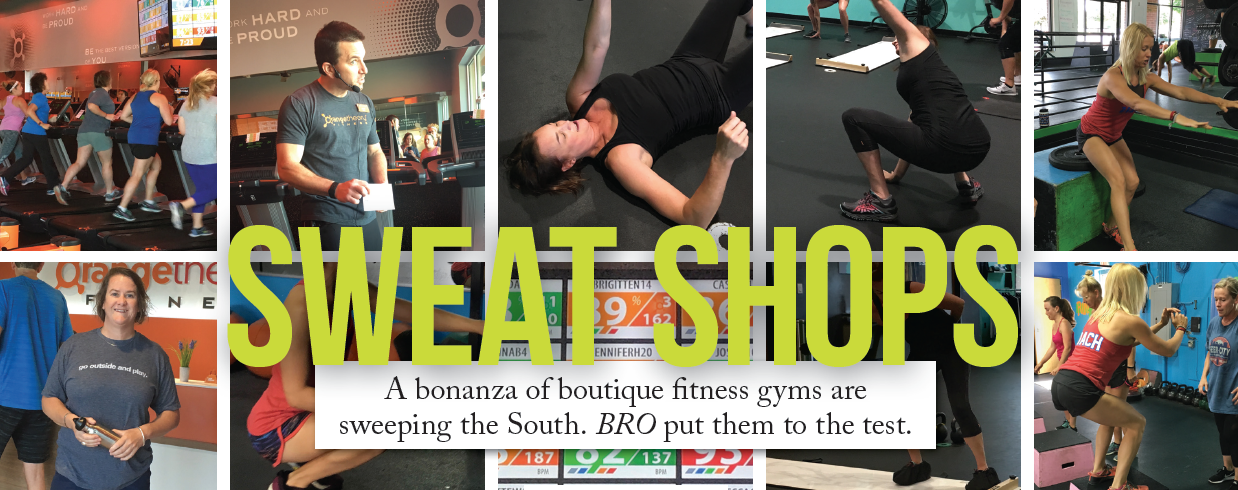As I walked across the parking lot to a crescendo of grunting, clanging weights, and erupting cheers, I’ll admit I was a bit intimidated. While I’ve never been a fan of the ellipticals, rigid circuit training, and meathead culture of traditional gyms. I’ve preferred to focus my fitness outside on activities I actually enjoy. But I couldn’t discount how many times I’d been told places like CrossFit were different. I approached my free intro session with nothing to lose, and left with a taste of sweat and a few tears, a little bit closer to discovering why “boutique” or specialty gyms are gaining traction in the fitness world.
I wasn’t the only first-timer in attendance that day, as I shared my tour, workout, and consultation with two other newbies. Our coach (as CrossFit likes to call its instructors) said this was common, and it seems to reflect national trends. According to the International Health, Racquet & Sportsclub Association (IHRSA), participation at specialty gyms grew by 70% between 2012 and 2015. They represented 42 percent of the health club market in 2014, and their popularity continues to climb.
In an effort to see just what all the fuss is about, BRO sent staff to test out CrossFit, Orangetheory, SoulCycle, MADabolic, Hard Exercise Works, and other boutique studios. Through our firsthand experiences and current industry research, we hope to give you a better grasp of the forces fueling this rising phenomenon and why it’s loved (and loathed) by fitness fiends and the workout weary alike.
The Appeal
Part of their growth can be explained by the niche’s lower overhead when compared to traditional gyms. Boutique studios are typically smaller operations and employ fewer staff members than goliath facilities like Gold’s Gym. Interestingly, however, much of their success is due to the preferences of younger generations.
Challenge
First, millennials are more likely to shun traditional gym equipment for the unconventional challenge of unique obstacles. In fact, the immediate difference I noticed between the CrossFit location I visited and a national gym chain was the presence of training equipment like ropes and obstacles, rowing machines, and even an outdoor lot for flipping tires.
Community
Next, according to the IHRSA’s 2016 Health Club Consumer Report, while Gen-X seems satisfied going solo and hitting the treadmill, millennials prefer the group feel of cross-training and yoga classes. Indeed, the most common response to my asking seasoned 20- to 30-something CrossFitters, “Why do you keep coming back?” was “because of the community.”
This feeling of camaraderie also transcends certain cohorts and extends beyond fellow participants to the trainers and other staff members. While observing the group classes, it quickly became clear that this investment in each others’ success fuels a growing community; it’s the sense that trainers are committed to participants’ success that motivates many to return.
Intensity
Furthermore, many favor high-intensity interval training (HIIT) for the alleged benefits of a more effective full-body workout in less time. One of our staff members, Martha Evans, gave Orangetheory a try. She says the studio’s high-intensity personal workout in a group format is encouraging, emphasizes individual help from coaches, and includes a heart rate monitor that tracks workout progress. “I feel like seeing my heart rate on the screen along with the rest of the class is really motivating. You get an email a few minutes after each class with your performance summary including the time you spent in each heart rate zone, along with calories burned and ‘splat’ points.”
The foundational theory behind Orangetheory’s motto “Work for one hour, burn for 36” is known as Excess Post-Exercise Oxygen Consumption, or EPOC. According to their website, “Our one-hour workout is designed to produce 12 minutes or more of intensities at 84% or higher of maximum heart rate. This program design produces workout ‘after burn’ effect, which is an increased metabolic rate for up to 36 hours after the workout.” The vehicles for this philosophy are splat points, which indicate minutes spent in the highest heart rate zones. The goal is to earn 12 splat points per class.
Mary Mac Motley spent the better part of two decades as an avid runner, averaging seven to eight miles per day and teaching bootcamp-style classes at various gyms. Fitness took a backseat, though, when she tore her PCL playing tennis and then started a PhD program shortly thereafter. “These two events changed my life, and I basically quit all exercise for about six years,” Mary said. “I gained weight and lost muscle. This year, after many people I love were diagnosed with cancer, I decided to motivate myself. I chose Hard Exercise Works (HEW) because it is known for being hard core. The program changes daily, and having once been super fit, the atmosphere is inspiring and seems doable.”
The Downside
Despite the many reasons specialty gyms are appealing, there are reasons past participants and some exercise professionals have become opponents. The dark side to the draw of community is that these gyms are often accused of feeling rather cult-like. This can be a turnoff for some first-time attendees, and I felt like a confused outsider when trying decipher CrossFit jargon and acronyms during my visit.
While seeing your stats change over time and compared to others’ can be a real motivator, for some, it’s more about how they feel and the physical markers of increased strength and stamina. In either case, these internal and external forms of feedback can cause participants to push themselves to (and past) their limit, making injuries more common at this type of gym.
Injury
Instructors largely encourage beginners to take it slow and only increase reps, weight, or workout length when they are ready. However, formats like CrossFit’s Workout of the Day (WOD), the goal of which is to complete as many sets as possible in a specified time frame, may inadvertently encourage participants to rush, leading many to sacrifice form and risk injury.
One study found that the injury rate in CrossFit is approximately 20 percent, with men more likely to sustain injury than women. While “the involvement of trainers in coaching participants on their form and guiding them through the workout correlates with a decreased injury rate,” some participants have been vocal about a lack of individualized attention, especially during the WODs. It’s quite possible these structured high-intensity workouts can prove a little too hard core.
Expense
Another significant turnoff is the price tag. Many gyms charge $20 to $40 per class, while monthly unlimited memberships can climb to $200 per month. Additionally, many studios specialize in a specific type of workout (such as SoulCycle) when compared to larger facilities’ diverse group and individual offerings and typically longer operating hours, leading critics to question why so many are happy to pay extra for fewer choices.
Is a boutique gym right for me?
Those new or returning to exercise often benefit the most from a customized regimen and guided workouts, while fitness veterans almost seem to run on autopilot, like they could perform a routine in their sleep. While beginners can certainly benefit from this format, specialty gyms also often attract dedicated athletes training for endurance races. My CrossFit coach also pointed out that many of his trainees are servicemen and -women getting back in shape for active duty.
So, it would seem that boutique gyms have struck a profitable balance by appealing to a wide range of skill levels. Most of this can be attributed to group exercise. In the words of Shawn Dolan Ph.D., group fitness “participants do not need to know how to develop a safe and effective workout. They simply have to show up with a positive attitude, participate, and most importantly, have fun. An exercise class structured with a purpose can be beneficial for people with limited knowledge about safe and effective exercise programming.”
It’s important to remember that not all boutique gyms are created equal; many have different philosophies on what’s most effective and why. SoulCycle offers a different experience from CrossFit or OrangeTheory, for example. So, while a better understanding of the differences in effectiveness between these modalities requires more research, one study highlighting the differences between CrossFit gains and weightlifting over time helps to shed light on the benefits and drawbacks of this trending style of training.
Published in the Journal of Exercise Physiology, this study compared the physical fitness of regular CrossFit participants to those utilizing traditional resistance training. It followed men between the ages of 20 and 32 of similar body composition, half of them CrossFit enthusiasts and half weightlifters. They were evaluated for relative arm strength, endurance, and lower body explosiveness.
The results? While the CrossFit practitioners exhibited greater endurance and jump capacities, the weightlifters showed more relative upper body strength. CrossFitters also had significant improvements in VO2max. Here, it becomes a question of your personal goals. What do you want to improve? Athletes hoping to improve endurance and stamina might stand to benefit more from a CrossFit-style regimen. If you’re looking to increase strength, however, you might want to steer clear; the study shows that CrossFit and similar workouts have the potential to negatively affect strength development in a phenomenon known as the interference effect, sacrificing improvements in maximal strength in favor of gains in explosive strength.
Fitness fad or revolution?
Specialty fitness studios are nothing new. CrossFit has been around for nearly 20 years, and it is still attracting aspiring athletes and converting big-box gym rats. It’s not likely that specialty gyms will fade out as quickly as the latest diet trend, but the luxury tag of boutique studios could prove to be their achilles heel. A few YMCAs are starting to offer more diverse classes like barre, TRX, and even something called ‘punk rope,’ looking to provide a similar culture at a much more palatable cost.
After saying my goodbyes and thanking my CrossFit coach, I walked back to my car, mulling over my workout and overall experience. While the community vibe is certainly attractive, the near-constant feedback, competitive drive, and pricey membership aren’t for me. I can see why specialty gyms attract a wide range of people, and while I hope it helps them reach their fitness goals healthily and happily, I think I’ll stick to sweating it out on the crags and trails.








